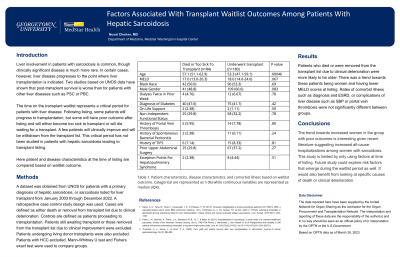Monday Poster Session
Category: Liver
P2390 - Factors Associated With Transplant Waitlist Outcomes Among Patients With Hepatic Sarcoidosis
Monday, October 23, 2023
10:30 AM - 4:15 PM PT
Location: Exhibit Hall

Has Audio

Nuval Cherian, MD
MedStar Washington Hospital Center
Washington, District of Columbia
Presenting Author(s)
Nuval Cherian, MD
MedStar Washington Hospital Center, Washington, DC
Introduction: Liver involvement in patients with sarcoidosis is common, though clinically significant disease is much more rare. In certain cases, however, liver disease progresses to the point where liver transplantation is indicated. Two studies based on UNOS data have shown that post-transplant survival is worse than for patients with other liver diseases such as PSC or PBC.
The time on the transplant waitlist represents a critical period for patients with liver disease. Following listing, some patients will progress to transplantation, but some will have poor outcome after listing and will either become too sick to transplant or will die waiting for a transplant. A few patients will clinically improve and will be withdrawn from the transplant list. This critical period has not been studied in patients with hepatic sarcoidosis leading to transplant listing.
Here patient and disease characteristics at the time of listing are compared based on waitlist outcome.
Methods: A dataset was obtained from UNOS for patients with a primary diagnosis of hepatic sarcoidosis, or sarcoidosis listed for liver transplant from January 2003 through December 2022. A retrospective case control study design was used. Cases are defined as either death or removal from transplant list due to clinical deterioration. Controls are defined as patients proceeding to transplantation. Patients still awaiting transplant or those removed from the transplant list due to clinical improvement were excluded. Patients undergoing living donor transplants were also excluded. Patients with HCC excluded. Mann-Whitney U test and Fishers exact test were used to compare groups.
Results: Patients who died or were removed from the transplant list due to clinical deterioration were more likely to be older. There was a trend towards these patients being women and having lower MELD scores at listing. Rates of comorbid illness such as diagnosis and ESRD, or complications of liver disease such as SBP or portal vein thrombosis were not significantly different between groups.
Discussion: The trend towards increased women in the group with poor outcomes is interesting given recent literature suggesting increased all-cause hospitalizations among women with sarcoidosis. This study is limited by only using factors at time of listing. Future study could explore risk factors that emerge during the waitlist period as well. It would also benefit from looking as specific causes of death or clinical deterioration.
Disclosures:
Nuval Cherian, MD. P2390 - Factors Associated With Transplant Waitlist Outcomes Among Patients With Hepatic Sarcoidosis, ACG 2023 Annual Scientific Meeting Abstracts. Vancouver, BC, Canada: American College of Gastroenterology.
MedStar Washington Hospital Center, Washington, DC
Introduction: Liver involvement in patients with sarcoidosis is common, though clinically significant disease is much more rare. In certain cases, however, liver disease progresses to the point where liver transplantation is indicated. Two studies based on UNOS data have shown that post-transplant survival is worse than for patients with other liver diseases such as PSC or PBC.
The time on the transplant waitlist represents a critical period for patients with liver disease. Following listing, some patients will progress to transplantation, but some will have poor outcome after listing and will either become too sick to transplant or will die waiting for a transplant. A few patients will clinically improve and will be withdrawn from the transplant list. This critical period has not been studied in patients with hepatic sarcoidosis leading to transplant listing.
Here patient and disease characteristics at the time of listing are compared based on waitlist outcome.
Methods: A dataset was obtained from UNOS for patients with a primary diagnosis of hepatic sarcoidosis, or sarcoidosis listed for liver transplant from January 2003 through December 2022. A retrospective case control study design was used. Cases are defined as either death or removal from transplant list due to clinical deterioration. Controls are defined as patients proceeding to transplantation. Patients still awaiting transplant or those removed from the transplant list due to clinical improvement were excluded. Patients undergoing living donor transplants were also excluded. Patients with HCC excluded. Mann-Whitney U test and Fishers exact test were used to compare groups.
Results: Patients who died or were removed from the transplant list due to clinical deterioration were more likely to be older. There was a trend towards these patients being women and having lower MELD scores at listing. Rates of comorbid illness such as diagnosis and ESRD, or complications of liver disease such as SBP or portal vein thrombosis were not significantly different between groups.
Discussion: The trend towards increased women in the group with poor outcomes is interesting given recent literature suggesting increased all-cause hospitalizations among women with sarcoidosis. This study is limited by only using factors at time of listing. Future study could explore risk factors that emerge during the waitlist period as well. It would also benefit from looking as specific causes of death or clinical deterioration.
Disclosures:
Nuval Cherian indicated no relevant financial relationships.
Nuval Cherian, MD. P2390 - Factors Associated With Transplant Waitlist Outcomes Among Patients With Hepatic Sarcoidosis, ACG 2023 Annual Scientific Meeting Abstracts. Vancouver, BC, Canada: American College of Gastroenterology.
